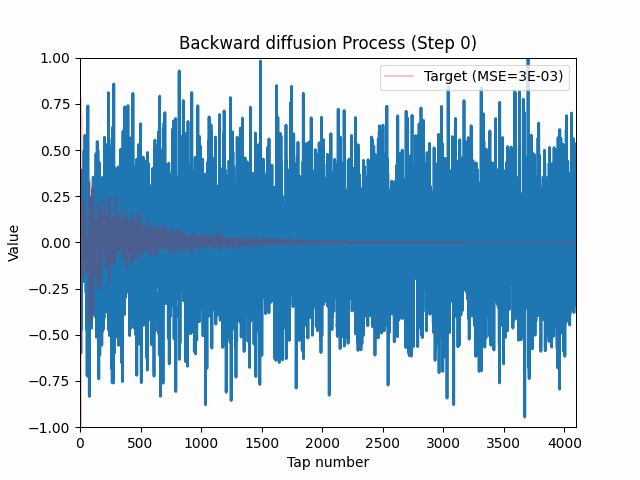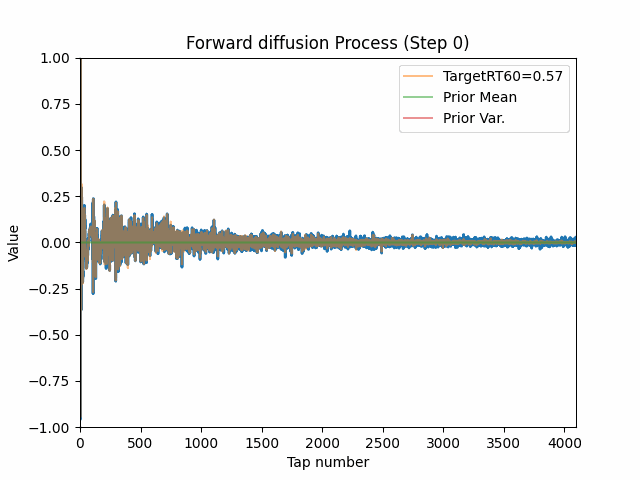The animations above respectively show examples of the backward (generation) and forward (learning) diffusion processes.
Eric Grinstein and Zehua Chen, Imperial College London
This project explores the usage of Denoising Diffusion Probabilistic Models (DDPMs) for the task of acoustic Room Impulse Response (RIR) generation.
A RIR is defined for two points in a room, namely, a source and receiver (i.e., a microphone) position. It encodes the three propagation effects which are applied to the raw or "dry" source signal, delay, attenuation and reverberation. Examples of rooms with a high reverberation time are cathedrals and bathrooms, both of which are good for singing. However, high reverberation also reduces speech inteligibility, which is a problem for hard of hearing people.
RIRs are frequently generated using the Image Source Method (ISM). However, this method is known to be computationally expensive. The FAST-RIR project proposes to train a Generative Adversarial Network (GAN) to learn RIRs, and shows that they are indeed faster than ISM.
As Diffusion Models have been shown to frequently outclass GANs in terms of generation quality, we decided to test them for this task. However, this project's current results were unable to beat FAST-RIR in terms of Mean Squared Error (MSE). We are releasing it as it's still very cool to see the diffusion process in action, and hopefully somebody can find the secret sauce.
We tested two different models, DiffWave and an Unet1D.
We condition the DiffWave model on a vector of size 10, namely, the room dimensions, source position, receiver position and reverberation time (RT60). The conditioning is applied in a similar way as in the original DiffWave paper, by adding it as a bias after the convolutions.
In the UNet1D model, the conditioning is done by introducing a mean prior on the initial noise signal which is added during the forward process. The mean of the added noise is set as the value of a low-order RIR computed using the ISM. Computing the ISM on a low order is quite cheap, giving rise to a hybrid RIR generator.
We explored three input
- Time Domain
- Time Domain (Scaled using Scikit-learn)
- Frequency domain (i.e. Transfer Function)
We tested two datasets, the original one proposed by FAST-RIR, and a custom one, generated using the GPU-RIR library, a fast implementation of the ISM on a GPU. The custom implementation uses more
You can test the code on Kaggle, where you can also download the datasets. Note you'll need a verified phone number to be able to use a GPU.
You can alternatively clone this repository and run it locally. You can create a conda virtual environment by running conda env create -f environment.yml.
You should then activate it using conda activate roomfuser.
There are three main scripts:
python visualize_backward.py, which generates RIRs from the conditioning.python visualize_forward.py, which transforms RIRs into noise, i.e., the forward process.python -m roomfuser logs, which trains the model
You can also use commands in the Makefile, if you are into that sort of stuff.
You can play with different feature extractors, etc in the file params.json file
If you use this in your research, please cite it. You can get a BibTeX citation by clicking "Cite this repository" on the right corner of this project's homepage.

